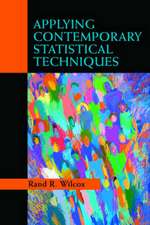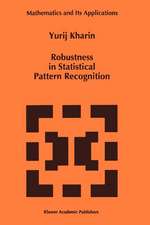Statistics
Autor Michael Sullivanen Limba Engleză Foi volante
Preț: 1106.64 lei
Preț vechi: 1437.19 lei
-23% Nou
Puncte Express: 1660
Preț estimativ în valută:
211.75€ • 221.68$ • 175.21£
211.75€ • 221.68$ • 175.21£
Carte indisponibilă temporar
Doresc să fiu notificat când acest titlu va fi disponibil:
Se trimite...
Preluare comenzi: 021 569.72.76
Specificații
ISBN-13: 9780134135373
ISBN-10: 0134135377
Pagini: 960
Dimensiuni: 211 x 274 x 33 mm
Greutate: 1.81 kg
Ediția:5
Editura: Pearson
ISBN-10: 0134135377
Pagini: 960
Dimensiuni: 211 x 274 x 33 mm
Greutate: 1.81 kg
Ediția:5
Editura: Pearson
Cuprins
- PART 1: GETTING THE INFORMATION YOU NEED
- 1. Data Collection
- 1.1 Introduction to the Practice of Statistics
- 1.2 Observational Studies versus Designed Experiments
- 1.3 Simple Random Sampling
- 1.4 Other Effective Sampling Methods
- 1.5 Bias in Sampling
- 1.6 The Design of Experiments
- PART 2: DESCRIPTIVE STATISTICS
- 2. Organizing and Summarizing Data
- 2.1 Organizing Qualitative Data
- 2.2 Organizing Quantitative Data: The Popular Displays
- 2.3 Additional Displays of Quantitative Data
- 2.4 Graphical Misrepresentations of Data
- 3. Numerically Summarizing Data
- 3.1 Measures of Central Tendency
- 3.2 Measures of Dispersion
- 3.3 Measures of Central Tendency and Dispersion from Grouped Data
- 3.4 Measures of Position and Outliers
- 3.5 The Five-Number Summary and Boxplots
- 4. Describing the Relation between Two Variables
- 4.1 Scatter Diagrams and Correlation
- 4.2 Least-Squares Regression
- 4.3 Diagnostics on the Least-Squares Regression Line
- 4.4 Contingency Tables and Association
- 4.5 Nonlinear Regression: Transformations (online) 4-1
- PART 3: PROBABILITY AND PROBABILITY DISTRIBUTIONS
- 5. Probability
- 5.1 Probability Rules
- 5.2 The Addition Rule and Complements
- 5.3 Independence and the Multiplication Rule
- 5.4 Conditional Probability and the General Multiplication Rule
- 5.5 Counting Techniques
- 5.6 Putting It Together: Which Method Do I Use?
- 5.7 Bayes's Rule (online) 5-1
- 6. Discrete Probability Distributions
- 6.1 Discrete Random Variables
- 6.2 The Binomial Probability Distribution
- 6.3 The Poisson Probability Distribution
- 6.4 The Hypergeometric Probability Distribution (online) 6-1
- 7. The Normal Probability Distribution
- 7.1 Properties of the Normal Distribution
- 7.2 Applications of the Normal Distribution
- 7.3 Assessing Normality
- 7.4 The Normal Approximation to the Binomial Probability Distribution
- PART 4: INFERENCE: FROM SAMPLES TO POPULATION
- 8. Sampling Distributions
- 8.1 Distribution of the Sample Mean
- 8.2 Distribution of the Sample Proportion
- 9. Estimating the Value of a Parameter
- 9.1 Estimating a Population Proportion
- 9.2 Estimating a Population Mean
- 9.3 Estimating a Population Standard Deviation
- 9.4 Putting It Together: Which Procedure Do I Use?
- 9.5 Estimating with Bootstrapping
- 10. Hypothesis Tests Regarding a Parameter
- 10.1 The Language of Hypothesis Testing
- 10.2 Hypothesis Tests for a Population Proportion
- 10.3 Hypothesis Tests for a Population Mean
- 10.4 Hypothesis Tests for a Population Standard Deviation
- 10.5 Putting It Together: Which Method Do I Use?
- 10.6 The Probability of a Type II Error and the Power of the Test
- 11. Inferences on Two Samples
- 11.1 Inference about Two Population Proportions
- 11.2 Inference about Two Means: Dependent Samples
- 11.3 Inference about Two Means: Independent Samples
- 11.4 Inference about Two Population Standard Deviations
- 11.5 Putting It Together: Which Method Do I Use?
- 12. Inference on Categorical Data



















